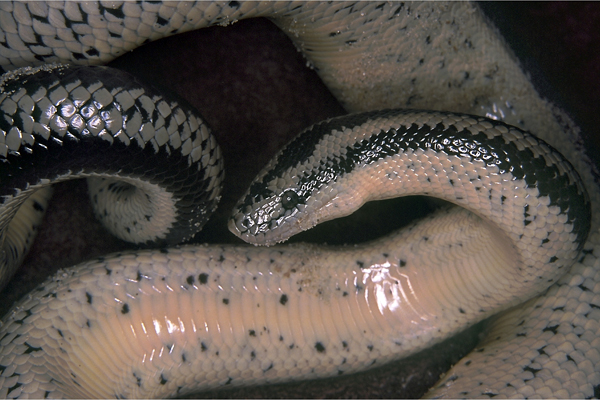Desert Rosy Boa

The Desert Rosy Boa (Lichanura trivirgata gracia) is a subspecies of the Rosy Boa, which is a non-venomous snake found in the southwestern United States and northwestern Mexico. Here are some key characteristics and information about the Desert Rosy Boa:
Appearance:
These boas are relatively small, with adults typically reaching lengths of 2 to 3 feet (60 to 90 cm). They have a stout body and a short tail, with a distinctive pattern of dark bands or stripes on a lighter background color. The coloration can vary, but they often have shades of pink, orange, and brown.Habitat:
Desert Rosy Boas are found in arid regions, including deserts and scrublands. They are adapted to live in areas with loose sandy soil and rocky terrain.Behavior:
Rosy Boas are generally nocturnal, meaning they are more active during the night. They are secretive snakes and often hide under rocks or in burrows during the day.Diet:
Their diet primarily consists of small mammals, such as rodents and lizards.Reproduction:
Rosy Boas are ovoviviparous, which means they give birth to live young rather than laying eggs. The number of offspring in a single litter can vary but is typically around 2 to 8.Conservation Status:
The Desert Rosy Boa is not considered to be globally threatened or endangered. However, like many reptiles, they face threats such as habitat loss and collection for the pet trade.Captive Care:
Some people keep Rosy Boas as pets. Captive care involves providing a suitable enclosure with hiding spots, proper temperature gradients, and a diet similar to their natural prey. It's essential to note that if you're considering keeping a Desert Rosy Boa or any snake as a pet, it's crucial to research their specific care requirements and ensure you can meet those needs before acquiring one. Additionally, always adhere to local regulations regarding the ownership of reptiles as pets.When speaking of the Boa family it may sound strange to hear of a member living in the Mojave Desert. We usually associate Boaís living in warm moist jungles to the south. This Boa is truly a member of the Boa family, however it doesnít reach the length of its cousins, being only about 2-3 feet long. Coloration may vary from slate gray to tan to pink but can always be identified by three broad stripes down itís back. The Rosy Boa has a very stocky and powerful body which it uses when squeezing itís prey. It also has very smooth scales and vertical pupils. The Rosy Boa is not an egg layer, and when born, the young are 6-15 inches and very susceptible to danger. It may be found in moister areas of the Mojave Desert near springs or permanent streams. The snake hunts in the early evenings and night for small mammals and birds.
Desert Riparian Habitat
Desert Riparian habitats are characterized as dense groves of low, shrublike trees or tall shrubs to woodlands of small to medium-sized trees. These habitats are found adjacent to permanent surface water, such as ...Source:
CDFW California Wildlife Habitat Relationships. Accessed [N/A]
https://wildlife.ca.gov/Data/CWHR